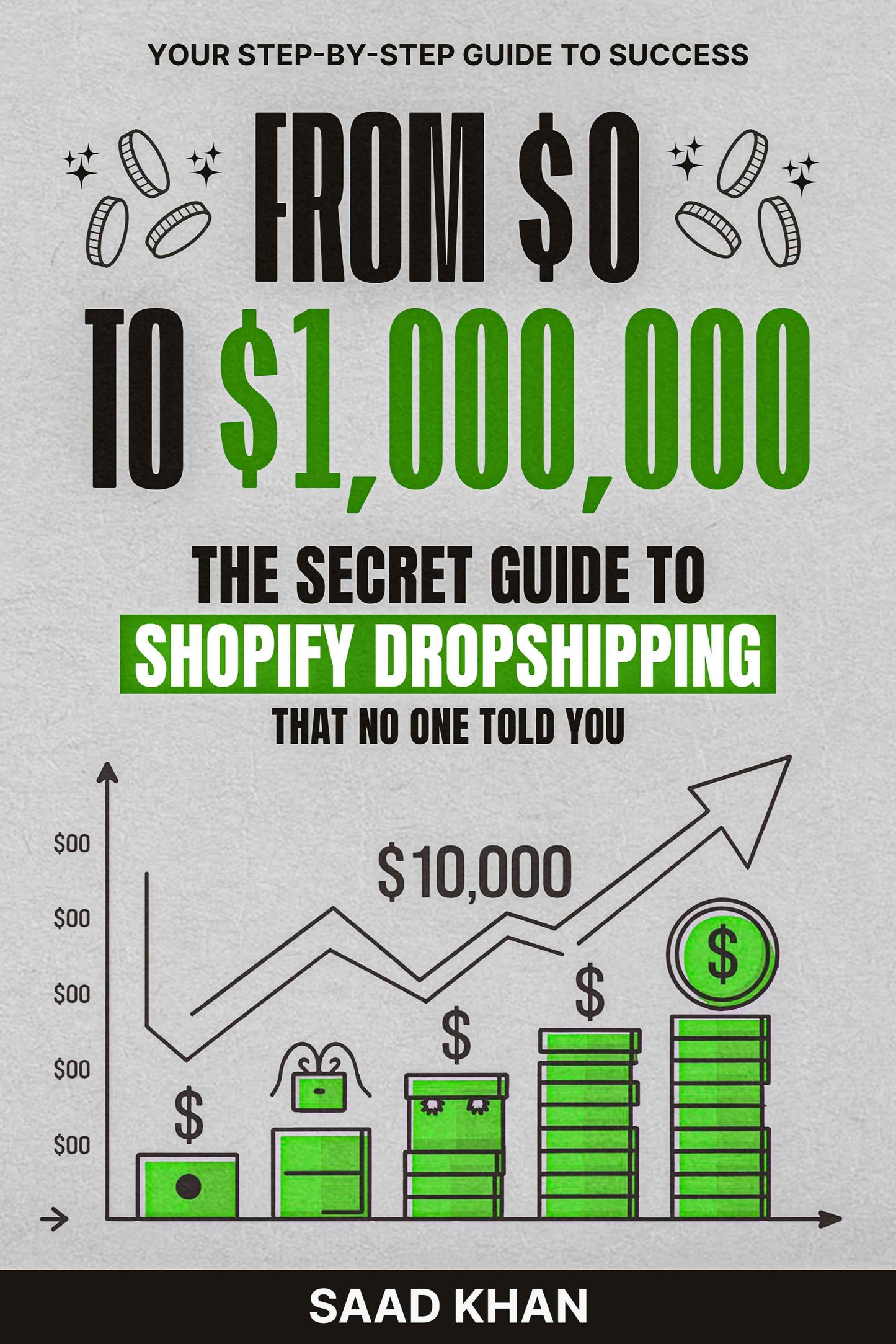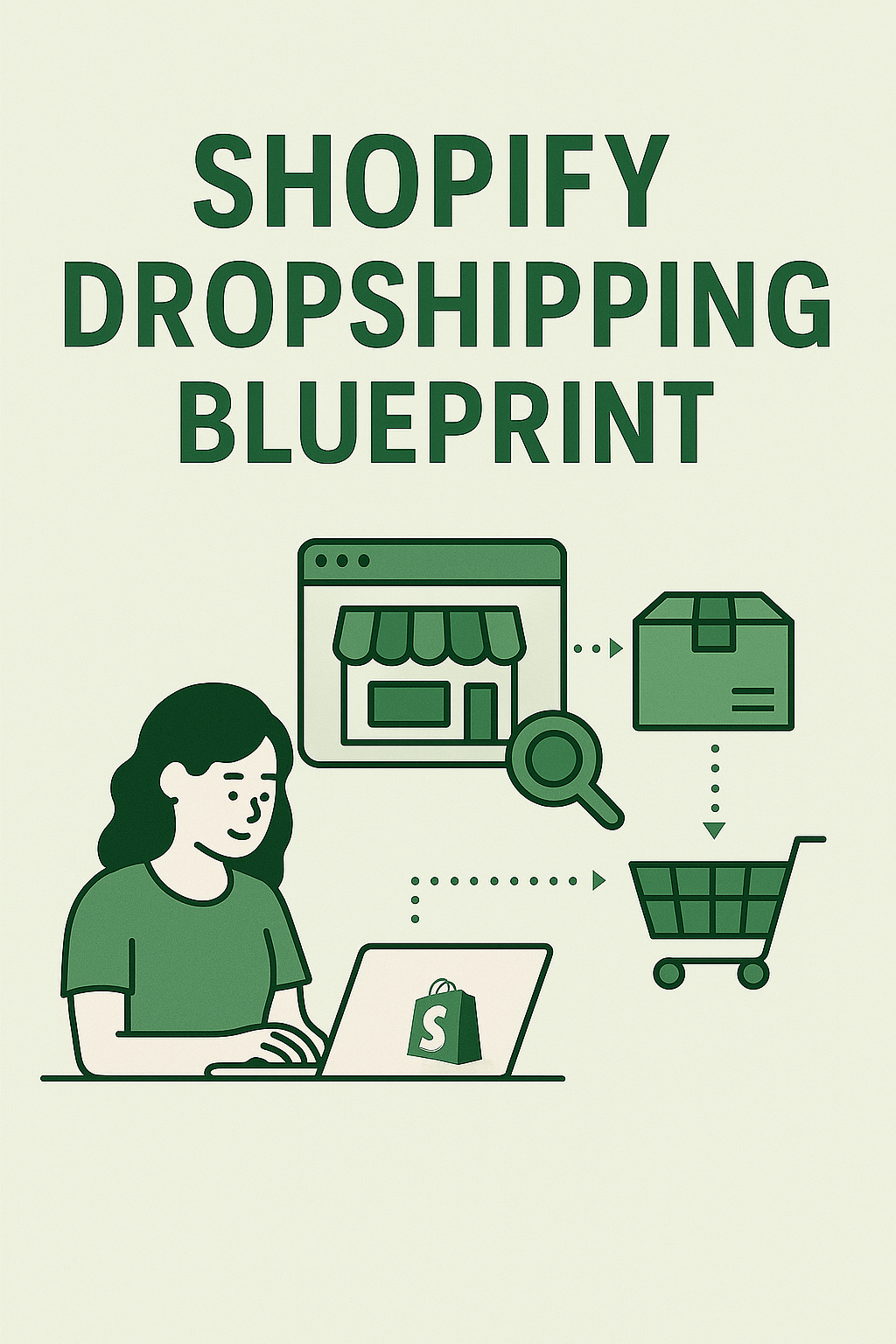E-Book
The Secret Guide to Shopify Dropshipping That No One Told You
The Secret Guide to Shopify Dropshipping That No One Told You
Couldn't load pickup availability
Secret Shopify Blueprint: Scale to $10K/Month in 30 Days PDF
Want to start a profitable dropshipping business but tired of free tutorials that only show results, not systems? This is your High Ticket Dropshipping Course and a complete step-by-step guide to launching and scaling a Shopify store. Without holding inventory or managing complex logistics.
Beginners Guide to Dropshipping in 2025 - Saad Khan
Built for ecommerce store owners, side hustlers, and aspiring entrepreneurs, this Blueprint walks you through the dropshipping model. It focuses on customer satisfaction, third party supplier vetting, and marketing strategies that convert.
- Beginner friendly Shopify store setup with free trial options
- Product selection framework using Google Trends and search results
- Inventory management tips to reduce costs and streamline fulfillment
- Reliable supplier directory + shipping costs calculator
- Legal and structural guidance for ecommerce business structure setup as sole proprietorship or LLC
This ultimate shopify dropshipping course suits anyone entering a dropshipping niche with high demand. It covers domain name setup, product listings, customer service workflows, and all essential steps to build a successful dropshipping store.
Download the Beginners Guide to Dropshipping in 2025 and take control of your ecommerce future.
Full Overview:
In this section, we’ll see how This Guide Helps You Build, Launch, and Scale a Dropshipping Business using proven tools, systems, and step-by-step strategies.
What Is Dropshipping and Why It Still Works in 2025
Why It Works
- Low entry barrier: No upfront inventory cost
- Scalability: Focus on scaling, not stock
- Minimal risk: Test products without financial pressure
How the Dropshipping Model Works for Store Owners + How to Dropship on Shopify
The dropshipping model lets store owners offer dropshipping products without holding any inventory. A third‑party supplier takes care of packaging and shipping each time a customer places an order. Thus you can concentrate on customer experience and high-performing marketing campaigns.
You’ll learn to build a strong brand and improve product listings. Streamline operations from order to delivery.
If you're wondering how to dropship on Shopify? It starts with setting up a store using beginner friendly tools, connecting with reliable suppliers. Using apps like DSers or Zendrop for automation makes the process fast, simple, and scalable.
You’ll also monitor supplier workflows and adapt to changes without disrupting your online store’s performance.
Phase 1: Research & Product Selection
Nail your Niche: Use proven research tools to analyze search results, trends, and competitor analysis for product selection. Focus on high demand items within product categories showing low competition. Evaluate product quality and validate ideas through customer reviews, competitor research, and insights from Google Trends.
Apply a product validation system:
- Use Koala Inspector to analyze best sellers
- Verify seasonality with Google Trends
- Scan TikTok for organic engagement
Dropshipping Platforms like Shopify offer a low barrier to entry in the global dropshipping market.
Though building a business takes hard work and some upfront investment, the benefits of dropshipping remain strong.
By using established online marketplaces, you don't need much money to start.
📌 Pro Tip: Great products solve annoying problems. Great brands make that solution feel premium while ensuring your target market sees the value.
You can also leverage market research surveys to understand what potential customers truly need. You can also run a quick Google search to compare similar products’ features.
Phase 2: Setting Up Your Ecommerce Store
Store Setup Essentials: Choose a brandable domain name and set up your Shopify store with a free trial. Establish a legal type of business such as sole proprietorship or Limited liability company. Develop brand identity with clear visuals, CTAs, and organized product listings on your eCommerce platform.
Recommended tools:
- Shopify
- Canva for design
- Klaviyo for email marketing
- DSers or Zendrop for selecting source products
Using pre-built templates and automation tools is a good way to speed up your Shopify store launch. Small initial investment can yield big returns if you pick the right niche. You’ll discover the best way to position your store products by analyzing wholesale price vs. retail price metrics.
Structure pages with bullet points, customer reviews, and benefit‑driven headlines—the small tweaks that boost conversion rates. Don’t forget to configure sales tax rules to avoid legal trouble.
Phase 3: Marketing Strategies That Attract Your Target Audience
Spend Wisely: Reach your target audience using strategic marketing strategies, email address capture, and positive reviews as social proof. Segment leads by behavior: first‑time visitors, cart abandoners, repeat customers. Implement automated flows with high open and conversion rates. Use Facebook Ads to target niche-specific audiences and drive traffic to your dropshipping store.
Bonus: These PDF Blueprints contain swipe files and funnel strategies to reduce the cons of dropshipping.
SEO for Organic Visibility
Get Free Organic Traffic: In addition to paid marketing, implement search engine optimization from day one:
- Optimize product-titles, URLs, and internal linking on product pages
- Write structured content for product descriptions
- Blog about your dropshipping niche and category topics for search relevance. Generating Free shipping interest pieces that rank
Invest in paid ads strategically to test offers, gather data, and scale winning campaigns quickly. Access the shopify SEO checklist and content calendar for consistent organic traffic.
Phase 4: Fulfillment, Service & Legal Setup
Work with a reliable supplier to ensure quality products, fast delivery, and accurate customer orders. Reduce shipping costs by comparing suppliers. Monitor inventory management and handle orders efficiently.
Most business owners find that building a relationship with a strong dropshipping partner is crucial for negotiating competitive prices. It ensures minimal upfront costs.
Stay compliant with local government requirements. Register your business, open a bank account, and set up sales tax rules. Draft refund and privacy policies to avoid legal trouble.
Order samples from suppliers before scaling. This helps ensure customer satisfaction and maintain strong relationships with your dropship supplier.
📌Pro Tip: Do not Rely on just one single supplier. Connect with multiple suppliers for order fulfillment in order to maintain quickest shipping and delivery.
Phase 5: Scaling and Optimization
Analyze sales data, launch A/B tests, and optimize pages. Improve your dropshipping journey by tracking metrics like ROAS, CTR, and refund rates. Launch Google Ads campaigns to capture high-intent buyers actively searching for your products. Conduct competitor research and retarget campaigns based on user behavior.
Track the performance of store products and iterate. Consider bundling popular products together or cross‑selling right products after initial purchase to boost lifetime value.
Measure supplier performance:
- Order accuracy
- Lead times
- Customer feedback
Use insights to scale winning products and eliminate underperformers, thereby maximizing good profit margins.
Bonus Tools & Downloads
Everything you need to simplify execution and avoid common pitfalls:
- Step guide checklists for store setup and product sourcing
- Competitor analysis templates and ad testing sheets
- Plug‑and‑play customer service scripts
- Editable product offerings and launch planners
- Business plan template with budget, timeline, and key tasks
The Low Startup Costs toolkit and powerful tools list simplify operations for new store owners. Use the easiest way to integrate analytics via a research tools dashboard for global market insights.
Handling Customer Complaints & Building Trust
Effective customer support goes beyond answering questions. It’s about resolving complaints quickly to maintain customer satisfaction and long-term loyalty. As your online store grows, create clear protocols for handling returns, refund requests, and damaged or delayed customer orders.
Best practices to manage complaints:
- Respond within 24 hours using live chat and professional customer service scripts.
- Offer clear refund or exchange policies (linked on your site).
- Use tracking numbers and proactive shipping updates to reduce inquiries.
- Train support staff (or use AI chat) to handle common objections or dis-satisfaction.
- Regularly review customer feedback to identify recurring issues.
- Handling negative reviews respectfully and resolving issues publicly can actually boost your credibility and conversions.
Final Thoughts: Build a Business, Not Just a Store
A great way to build a scalable brand is by focusing on systems—not just products. This ultimate guide helps you navigate global drop-shipping market & turn your online store into a profitable asset.
For many entrepreneurs, dropshipping is a side hustle that grows into a successful dropshipping business with right initial investment. Use the right strategy and work with a vetted supplier. Stay consistent, and you'll save money while building a strong brand that stands out online.
Download The Complete Shopify Dropshipping Guide for beginners and take charge of your ecommerce future today.
Scan The QR to Download The E-book




